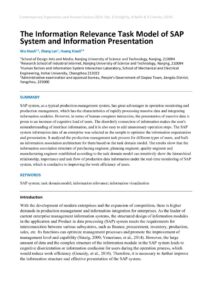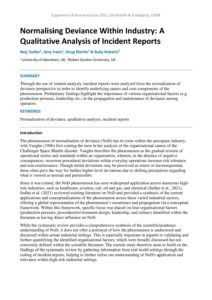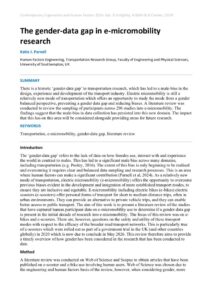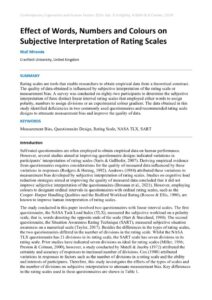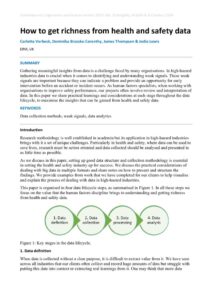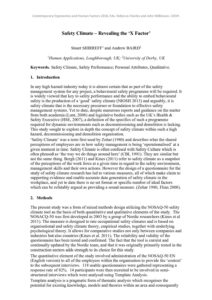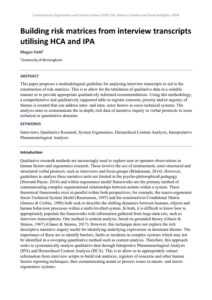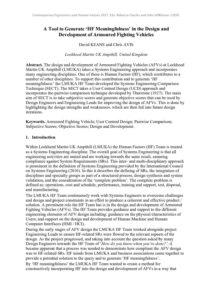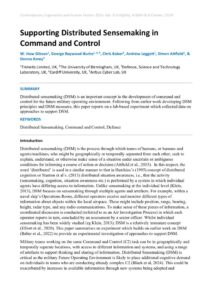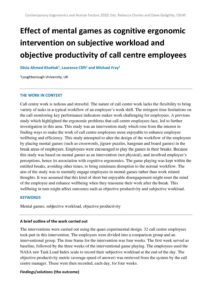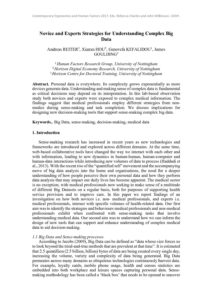Data
The Information Relevance Task Model of SAP System and Information Presentation
| Document | Author Wu Xiaoli, Zhang Lan, Huang Xiaoli |
| Abstract SAP system, as a typical production management system, has great advantages in operation monitoring and production management, which has the characteristics of rapidly processing massive data and integrating information modules. However, in terms of human-computer interaction, the presentation of massive data is prone to an increase of cognitive load of users. The disorderly connection of information makes the user's misunderstanding of interface information, and it is also easy to add unnecessary operation steps. The SAP system information data of an enterprise was selected as the sample to optimize the information organization and presentation. It analyzed the production management task process for different types of users, and built an information association architecture for them based on the task domain model. The results show that the information association structure of purchasing engineer, planning engineer, quality engineer and manufacturing engineer established according to the task domain model can intuitively show the hierarchical relationship, importance and task flow of production data information under the real-time monitoring of SAP system, which is conducive to improving the work efficiency of users. |
Normalising Deviance Within Industry: A Qualitative Analysis of Incident Reports
| Document | Author Nejc Sedlar, Amy Irwin, Doug Martin & Ruby Roberts |
| Abstract Through the use of content analysis, incident reports were analysed from the normalisation of deviance perspective in order to identify underlying causes and core components of the phenomenon. Preliminary findings highlight the importance of various organisational factors (e.g. production pressure, leadership etc.) in the propagation and maintenance of deviance among operators. |
The gender-data gap in e-micromobility research
| Document | Author Katie J. Parnell |
| Abstract There is a historic ‘gender-data gap’ in transportation research, which has led to a male-bias in the design, experience and development of the transport industry. Electric micromobility is still a relatively new mode of transportation which offers an opportunity to study the mode from a gender balanced perspective, preventing a gender data gap and reducing biases. A literature review was conducted to review the sampling of participants across 296 studies into e-micromobility. The findings suggest that the male-bias in data collection has persisted into this new domain. The impact that this has on this area will be considered alongside providing areas for future research. |
Effect of Words, Numbers and Colours on Subjective Interpretation of Rating Scales
| Document | Author Niall Miranda |
| Abstract Rating scales are tools that enable researchers to obtain empirical data from a theoretical construct. The quality of data obtained is influenced by subjective interpretation of the rating scale or measurement bias. A survey was conducted on eighty-two participants to determine the subjective interpretation of three distinct linear interval rating scales that employed either words to assign polarity, numbers to assign divisions or an experimental colour gradient. The data obtained in this study identified deficiencies in two commonly used questionnaires and recommended rating scale designs to attenuate measurement bias and improve the quality of data. |
How to get richness from health and safety data
| Document | Author Carlotta Vorbeck, Dominika Brzoska-Corenthy, James Thompson & Jodie Lewis |
| Abstract Gathering meaningful insights from data is a challenge faced by many organisations. In high-hazard industries data is crucial when it comes to identifying and understanding weak signals. These weak signals are important because they can indicate a problem and provide an opportunity for early intervention before an accident or incident occurs. As human factors specialists, when working with organisations to improve safety performance, our projects often involve review and interpretation of data. In this paper we share practical learnings and considerations at each stage throughout the data lifecycle, to maximise the insights that can be gained from health and safety data. |
Safety Climate – Revealing the ‘X Factor’
| Document | Author Stuart SHIRREFF and Andrew BAIRD |
| Abstract |
Building risk matrices from interview transcripts utilising HCA and IPA
| Document | Author Megan Field |
| Abstract This paper proposes a methodological guideline for analysing interview transcripts to aid in the construction of risk matrices. This is to allow for the tabulation of qualitative data in a suitable manner as to provide appropriate qualitatively informed recommendations. Using this methodology, a comprehensive and qualitatively supported table to register concerns, priority and/or urgency of themes is created that can address inter- and intra- actor factors in socio-technical systems. The analysis aims to communicate the in-depth, rich data of narrative inquiry in verbal protocols to more technical or quantitative domains. |
A Tool to Generate ‘HF Meaningfulness’ in the Design and Development of Armoured Fighting Vehicles
| Document | Author David KEANE and Chris AVIS |
| Abstract The design and development of Armoured Fighting Vehicles (AFVs) at Lockheed Martin UK Ampthill (LMUKA) takes a Systems Engineering approach and incorporates many engineering disciplines. One of these is Human Factors (HF), which contributes to a number of other disciplines. To support this contribution and to generate ‘HF meaningfulness’ the LMUKA HF Team developed the Systems Engineering Comparison Technique (SECT). The SECT takes a User Centred Design (UCD) approach and incorporates the pairwise comparison technique developed by Thurstone (1927). The main aim of SECT is to take subjective scores and generate objective scores that can be used by Design Engineers and Engineering Leads for improving the design of AFVs. This is done by highlighting the design strengths and weaknesses, which are then fed into future design iterations. |
Supporting Distributed Sensemaking in Command and Control
| Document | Author W. Huw Gibson, George Raywood-Burke, Chris Baber, Andrew Leggatt, Simon Attfield, & Donna Amey |
| Abstract Distributed sensemaking (DSM) is an important concept in the development of command and control for the future military operating environment. Following from earlier work developing DSM principles and DSM measures, this paper reports on a lab-based experiment which collected data on approaches to support DSM. |
Effect of mental games as cognitive ergonomic intervention on subjective workload and objective productivity of call centre employees
| Document | Author Silvia Ahmed Khattak, Laurence Clift and Michael Fray |
| Abstract Call centre work is tedious and stressful. The nature of call centre work lacks the flexibility to bring variety of tasks in a typical workflow of an employee’s work shift. The stringent time limitations on the call monitoring key performance indicators makes work challenging for employees. A previous study which highlighted the ergonomic problems that call centre employees face, led to further investigation in this area. This study was an intervention study which rose from the interest in finding ways to make the work of call centre employees more enjoyable to enhance employee wellbeing and efficiency. This study attempted to alter the design of the workflow of the employees by placing mental games (such as crosswords, jigsaw puzzles, hangman and board games) in the break areas of employees. Employees were encouraged to play the games in their breaks. Because this study was based on mental games as an intervention (not physical), and involved employee’s perceptions, hence its association with cognitive ergonomics. The game playing was kept within the entitled breaks, avoiding other times, to bring minimum disruption to the normal workflow. The aim of the study was to mentally engage employees in mental games rather than work related thoughts. It was assumed that this kind of short but enjoyable disengagement might reset the mind of the employee and enhance wellbeing when they reassume their work after the break. This wellbeing in turn might affect outcomes such as objective productivity and subjective workload. |
Novice and Experts Strategies for Understanding Complex Big Data
| Document | Author Andreas REITER, Xianxu HOU, Genovefa KEFALIDOU, James GOULDING |
| Abstract Personal data is everywhere. Its complexity grows exponentially as more devices generate data. Understanding and making sense of complex data is fundamental as critical decisions may depend on its interpretation. In this lab-based observation study both novices and experts were exposed to complex medical information. The findings suggest that medical professionals employ different strategies from non-medics during sense-making and task completion. We discuss implications for designing new decision-making tools that support sense-making complex big data. |

